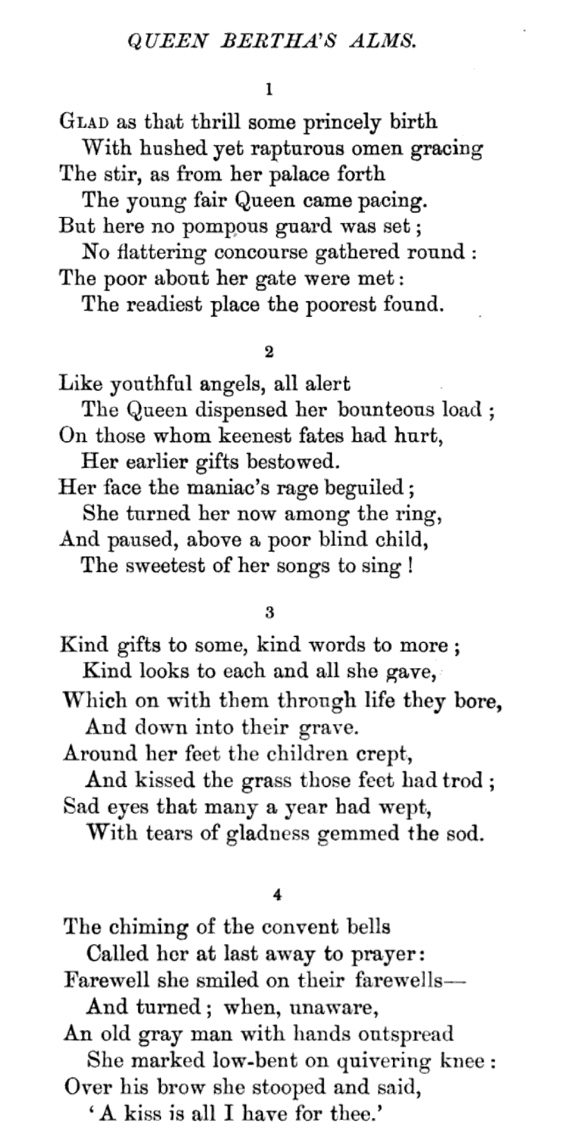Navigation auf uzh.ch
Navigation auf uzh.ch
This is one of a sequence of four poems by Aubrey De Vere on Queen Bertha of Swabia, who spent the latter part of her life at Payerne Priory:
Please contact us at scis-zjjf@es.uzh.chif you'd like to do a recording of this poem.
Note: The following text is a slightly adapted and abbreviated version of a text published at https://www.fribourgregion.ch/en/P12798/bertha-of-swabia (accessed 6 November 2020).
"Queen Bertha [of Swabia], who lived between 907 and 966 AD, [...] founded the Cluniac Priory [in Payerne].
Back in the 10th century, Payerne was part of the mighty Kingdom of Burgundy, which encompassed both sides of the Jura mountain range, and where kings waged war in a bid to expand their empire and reign supreme.
In 918, Rudolf II, the then King of Burgundy, launched an attack on the territory of Germania and the powerful Duke Burchard of Swabia. After fierce fighting, the sworn enemies laid down their arms and formed an alliance.
This was cemented two years later when Rudolf II married Bertha, the daughter of his former foe. Together they reigned over the Lombard Kingdom from their base in Pavi. During this time Bertha bore the king three children: Conrad (later known as 'Conrad the Peaceful'), Adelaide, future empress of Germania, and Rudolf, who would later become the ruler of Alsace. In 926, Rudolf II was killed in battle, fending off a hostile invasion by the Onogurs, a nomadic Hungarian tribe.
With the death of Rudolf II, the 2nd King of Italy, Hugh of Arles, immediately spotted an opportunity to expand his realm. For Bertha, now left to raise her children alone and with a court beset by power struggles and intrigue, Rudolf II was to become her knight in shining armour. When they finally wed in 93, Hugh kept his sights firmly fixed on 12-year-old Conrad, the heir to the throne. He betrothed his son Lothair to Adelaide, Conrad's sister. The news was met with indignation by the other bellicose monarchs.
Otto I, King of Germania, realised that a reunified kingdom of Italy would present a major threat and promptly abducted Conrad, who would grow up a prisoner of the German court. Otto I would later marry Adelaide, Lothair's widow, who became the first Empress of the German Empire. So, what of Bertha? It was during these troubled times that she came to the site of modern-day Payerne in search of sanctuary from the machinations of her court and her husband’s serial adultery.
Emotionally battered and bruised, Bertha sought out the peace and tranquillity of Payerne Priory. But the war had left deep scars and the Saracen pirates continued to torment the local peasants, who fought back as best they could. Bertha decided that something had to be done. She raised an army to drive out the Spanish marauders once and for all, and called on the Benedictine monks of Cluny to rebuild the monastery and teach the women how to spin wool so that they could have a much-needed source of income. From then, the legend of Queen Bertha was born: surveying her domain on horseback, threading her distaff and doing good works. [...]
In her famous will, which is thought to have been completed by her daughter and the monks, Bertha bequeathed [... a] magnificent priory [to Payerne], a testament to the life of a queen who always had the best interests of her subjects at heart."
